Dismantling
Attention! The engine can be dismantled from the car as part of the power unit (those. complete with transmission), then the transmission is separated from the engine for overhaul.
The power unit is lowered and gets out from under the car. In order to freely get the engine in this way, the car must be raised to a height of at least 75 cm (floor to front bumper) and place on stands.
1. Park the vehicle on a firm, level surface. Block the rear wheels, apply the handbrake. Raise the front of the vehicle and place it on stands in compliance with all safety regulations.
2. Remove the front wheels.
3. Loosen the screws and remove all crankcase guards and engine mudguards.
4. Remove the hood.
5. Drain the coolant into a vessel (if the liquid is suitable for further use).
6. Drain the gearbox oil. Screw in the drain plug and the control/filler plug, tighten both plugs to the specified torque.
7. If the engine is to be disassembled, drain the oil and, if necessary, remove the oil filter. Clear and wrap a drain stopper, tighten with the set moment.
8. Remove the radiator assembly with hoses and fans.
9. Remove the alternator and disconnect the wiring from the starter.
10. Remove the power steering pump.
Carburetor engines
11. On carbureted engines, remove or disconnect the following parts and assemblies:
- air filter;
- fuel supply hose and return hose from the fuel pump (plug all openings to prevent fuel loss and dirt ingress);
- throttle cable;
- wiring connectors from the carburetor;
- brake booster vacuum hose, coolant hose, valve vacuum hoses and crankcase ventilation hoses mounted on the intake manifold;
- suction manifold support bracket;
- muffler intake pipe.
12. On vehicles equipped with a catalytic converter, disconnect the connector from the exhaust gas sensor.
Single nozzle injection engines
13. On single nozzle injection engines (with preliminary preparation of the fuel mixture) remove the air filter.
14. Decompress the fuel system, disconnect the fuel supply hose and the fuel return hose from the throttle body (plug all openings to prevent fuel loss and dirt ingress).
15. Disconnect the throttle cable.
16. Disconnect the wiring connectors from the throttle chamber, intake manifold and other parts.
17. Disconnect the brake booster vacuum hose, coolant hose, valve vacuum hoses and crankcase ventilation hoses mounted on the intake manifold.
18. Remove the suction manifold support bracket.
19. Remove the muffler intake pipe.
Injection engines with direct fuel injection
20. On injection engines with direct fuel injection, remove the air filter duct.
21. Carry out measures to decompress the fuel system, disconnect the fuel supply hose and the fuel return hose from the throttle valve chamber (plug all openings to prevent fuel loss and dirt ingress).
22. Disconnect the throttle cable.
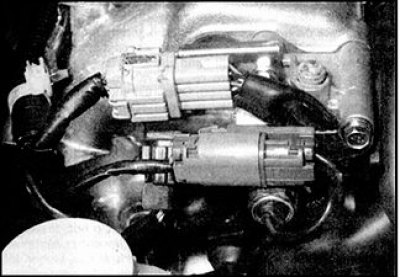
23. Disconnect the wiring connectors from the throttle chamber, intake manifold and other parts. Move the wiring away from the manifold and cylinder head so that it does not interfere with the removal of the engine.
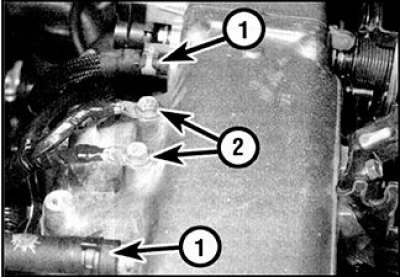
24. Disconnect the brake booster vacuum hose, coolant hose, valve vacuum hoses (1) and crankcase ventilation hoses from the intake manifold (2 - ground bolts).
25. Remove the suction manifold support bracket.
26. Loosen the clamps and disconnect the heater hoses and other hoses of the cooling system from the engine, having previously marked the original location of each hose.
27. On vehicles equipped with air conditioning, remove the compressor mounting bolts and move the compressor to the side. Tie the compressor to the body so that its weight is not perceived by the tubes and hoses of the air conditioning line. Do not disconnect air conditioning hoses.
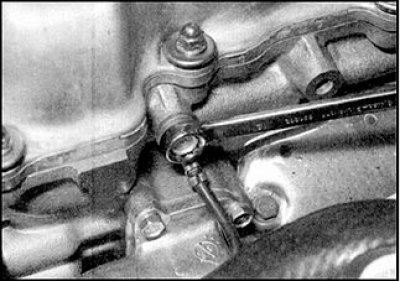
28. Guided by the description (see subsection 7.7.4), disconnect all wiring connectors from the ignition distributor, ignition coil and transistor power supply. Release the wiring sleeve from the clips on the cylinder head and take it to the side. Turn away bolts and remove all wires of connection with weight on a head of cylinders and on a soaking-up manifold.
29. Turn away bolts and remove all wires of connection with weight on a head of cylinders
30. Remove axle shafts complete with cardan joints (see subsection 10.2).
31. Disconnect the clutch cable from the gearbox (see subsection 8.3).
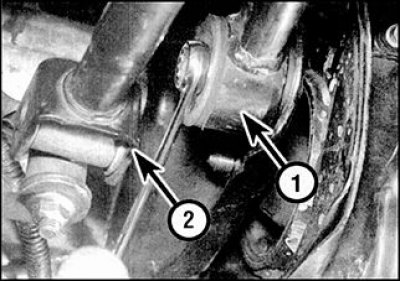
32. Disconnect the shift rod from the gearbox (1), shift rods (2), speedometer cable and wiring connectors.
33. Bring the lift hoist and fix it on the cylinder head brackets, tighten the hoist so that it takes the weight of the power unit.
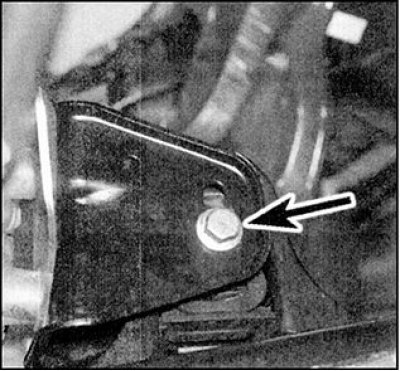
34. Use paint or marker to mark the location of the pinch bolt (indicated by an arrow) on the front support bracket of the power unit in order to install this bolt in its original position during assembly.
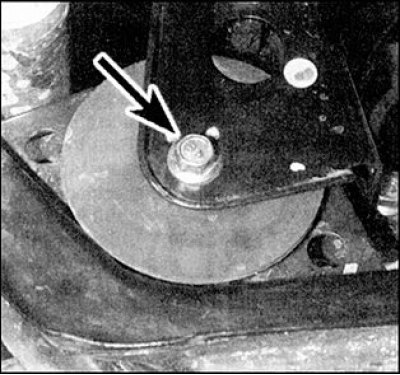
35. Loosen the tightening and unscrew the tie bolt nut (indicated by an arrow), remove the bolt from the support. Turn away a nut and get a coupling bolt of a back support of the power unit.
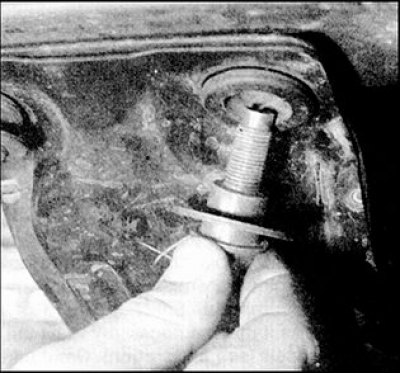 | 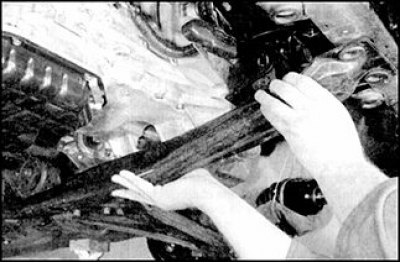 |
36. Unscrew the four bolts securing the central side member, remove the side member, removing it from under the power unit.
37. Turn away a nut and get a coupling bolt of the right support of the power unit, then turn away bolts of fastening of a support and get a support from a motor compartment.
38. If the fit of the rubber pads mounted on both sides of the support bracket on the body side is loose, remove the pads.
39. Turn away and get a coupling bolt of the left support of the power unit. Then unscrew the three bolts securing the support to the gearbox and move the support to the side. If the rubber pads on both sides of the support bracket are loose, remove the pads.
40. Once again, make sure that all parts, wires and hoses that may interfere with the dismantling of the power unit are disconnected or removed. Also make sure that when dismantling the unit, other parts of the car will not be deformed or damaged (e.g. linkage and gearshift control rod).
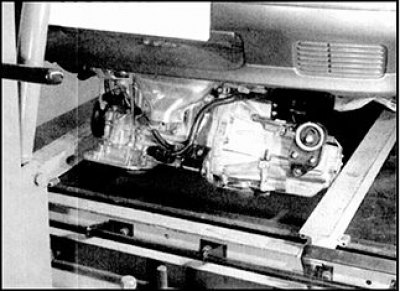
41. If there is a low cart, then roll it under the engine, which will make it easier to remove the removed unit from under the car. Lower the power unit, being careful not to damage or snag nearby parts. It is advisable to carry out this operation with an assistant, since it will be necessary to tilt the unit slightly so as not to touch the body panels. Be extremely careful when lowering the engine.
42. Roll the power unit out from under the car.
Removing the gearbox from the engine
1. Secure the removed power unit with wooden blocks by placing it on a workbench or on a clean, level area in the workshop.
2. Turn away bolts and remove a starter.
3. Make sure that the power unit is securely fixed and unscrew the bolts securing the gearbox housing to the engine. Mark bolt locations (and on some vehicles and the corresponding brackets), to install when reassembling in their original places.
4. Carefully separate the gearbox from the engine, making sure that the weight of the gearbox is not taken up by the input shaft as it exits the clutch disc.
5. If the gearbox locating pins wiggle freely, remove them and store them in order to reinstall them later.
Installation
1. If the gearbox was removed from the engine, then perform the operations described below in paragraphs. 2–6. If the gearbox has not been removed, then carry out the installation guided by item 7 and so on.
2. Apply a thin layer of refractory grease to the splines of the gearbox input shaft. Excess lubrication is not allowed, otherwise oiling of the friction disc is possible.
3. Install the pins on the engine or gearbox (if filmed), make sure the release bearing is securely attached to the clutch release fork.
4. Carefully install the gearbox on the engine along the guide pins. During installation, the weight of the gearbox should not be taken by the input shaft when the shaft enters the splines of the clutch disc.
5. Wrap the gearbox housing mounting bolts, making sure that all brackets are installed correctly, tighten the bolts to the specified torque.
6. Install starter and tighten bolts.
7. Position the power unit under the vehicle and attach the hoist to the engine brackets.
8. Working with an assistant, lift the power package into the engine compartment, being careful not to hit any nearby parts.
9. Install the rubber cushions on the bracket of the left support of the power unit, making sure that the studs of the cushions fit into the holes of the bracket. Reinstall the support, wrap the bolts securing the support to the gearbox and tighten them to the specified torque. Insert the pinch bolt and hand tighten the nut.
10. Install the rubber pads to the right suspension bracket from the body side, making sure that the pad studs fit into the holes in the bracket. Install the support and tighten the bolts to the specified torque. Insert the pinch bolt and hand tighten the nut.
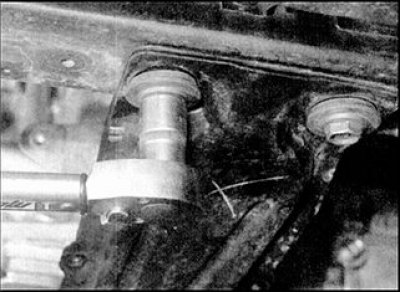
11. Make sure all rubber pads are in place. Install the restrictive ring on the rear support. Install the central side member, tighten the bolts, after putting washers on them and tighten by hand. Tighten the side member bolts to the specified torque.
12. Insert the rear support pinch bolt and hand-tighten the nut.
13. Insert the front support pinch bolt. Orient the power unit so that the front mount pinch bolt aligns exactly with the mark made before disassembly, then tighten the bolt to the specified torque.
14. Rock the power unit, settling it in place, then tighten the front, right and left mount pinch bolts to the specified torque.
15. Further, the installation of the power unit is carried out in the reverse order. When installing, make sure that the wiring is routed and secured with clamps and brackets, and that all connectors are connected.
15. Replace the axle shaft seals and install the axle shafts on the gearbox.
16. Attach all hoses of system of cooling and fix collars.
17. Adjust the throttle cable.
18. Connect and adjust the clutch cable (see subsection 8.3).
19. Install and adjust drive belts.
20. Change the oil in the engine and gearbox, recommended oil grades and filling volumes (see subsection 1.12.7).
21. Fill with coolant.
22. When finished, start the engine and check for leaks.